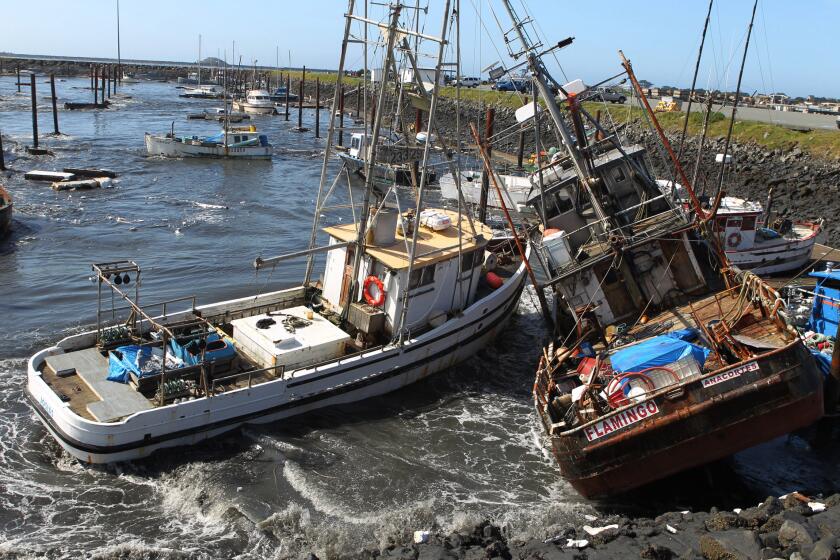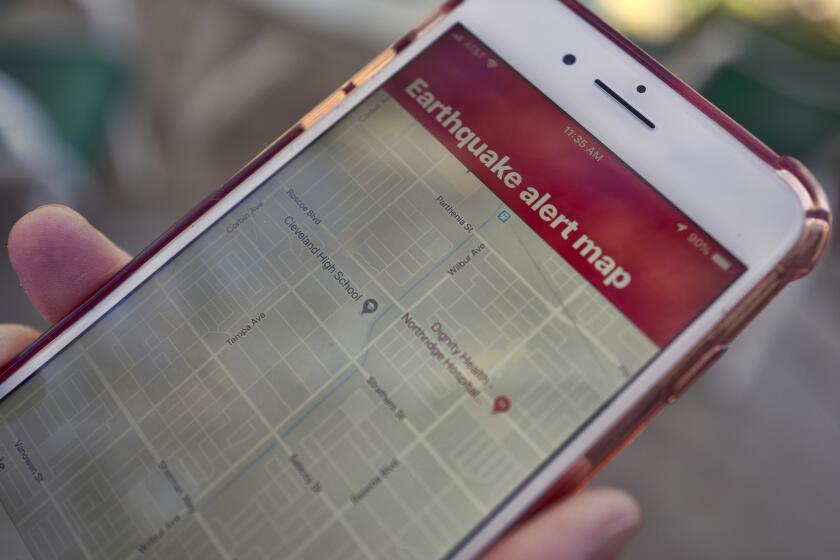Softening the Jolt of ‘The Big One’ : USC Hospital Will Be First in U.S. to Use Bearings Designed to Lessen Seismic Shock
- Share via
When an earthquake measuring 6.4 on the Richter scale rumbled through the Southland on Feb. 9, 1971, it took its deadliest toll at two hospitals in Sylmar.
Forty-six people died when two buildings at the Veterans Hospital crashed in a pile of rubble, and two more were killed when a pair of buildings collapsed at Olive View Hospital nearby.
But if a high-tech “seismic isolation system” being installed underneath a new hospital at the USC Health Sciences campus east of downtown Los Angeles lives up to expectations, the building will be one of the safest places in town if--or when--the widely expected “big one” hits the Southland.
The seismic isolation system consists of 149 specially designed rectangular bearings. The new medical facility is believed to be the first hospital in the United States to use it.
Although small--about two feet on a side and one foot high--each bearing weighs about 1,000 pounds and costs about $5,000. Most of them have a lead core wrapped with alternating layers of rubber and steel.
The bearings sit on the concrete-and-steel foundation of the hospital and will be topped by steel columns that will support the building when it is completed in 1991. Each bearing is designed to support 1 million pounds.
When an earthquake comes, the bearings will sway back and forth as they--not the building itself--absorb and then dissipate most of the energy from the ground.
The hospital will sway, too, but only very little because the bearings underneath will soak up most of the quake’s force.
“The bearings act like ‘seismic shock absorbers,’ absorbing the energy that would otherwise travel into the building and cause damage,” said Stephen M. Weissberg of Dynamic Isolation Systems Inc., the Berkeley-based firm that designed the system for the hospital and a dozen other structures across the United States.
Thanks to these “shock absorbers,” Weissberg said, the building will respond to an earthquake measuring a whopping 8.0 on the Richter scale as if it were a moderate 5.5 shaker.
The isolation system is designed to solve a problem that has vexed architects, engineers and other construction professionals for decades: How to make buildings with fewer than a dozen or so floors better able to handle quakes and minimize damage.
Modern skyscrapers usually don’t get badly damaged during quakes because their sheer height makes them more flexible and better able to “throw off” quake-generated energy.
Buildings in the 3- to 12-story range usually don’t fare as well, Weissberg said, because they aren’t tall enough to fully dissipate the energy. Instead, they remain rigid as they try to absorb the quake’s power and--as was the case with the VA and Olive View hospitals in the ’71 quake--the shaking that results can cause huge amounts of damage.
Because the bearings soak up most of a quake’s force, a seismic isolation system “makes short buildings act like tall ones,” Weissberg said.
About two-thirds of the bearings that will be used at the new hospital have already been installed. The rest are expected to be in place within the next 30 days, said Arthur Stephenson, a construction inspector for National Medical Enterprises Inc.
NME will own and operate the 275-bed hospital, near County/USC Medical Center.
The concept of seismic isolation isn’t new. In fact, a British doctor began toying with the idea in the early 1900s. But it took the creation of complex computer programs and other earthquake-testing tools to make the construction of the systems possible.
About 125 buildings in the world have seismic isolation systems similar to the one being installed at the new hospital, but most of those structures are in the quake-prone countries of Japan and New Zealand.
No Structural Damage
Although the systems have been laboratory-tested to see how they would perform in quakes rated as high as 8.0 on the Richter scale, the highest real-life quake withstood by one of the buildings registered about 6.5 on the Richter. Weissberg said that building, in Japan, suffered no structural damage.
Another 20 of the structures have experienced “moderate” quakes in the 5.0 to 6.0 range, he said, and all of them received little or no damage.
The only other Southland building believed to have a similar system is the four-story Foothill Communities Law and Justice Center in Rancho Cucamonga.
Two other Southland buildings, however, will install seismic-isolation systems soon.
One is the new emergency dispatch and command center that the county is building in East Los Angeles. The structure will serve as the “nerve center” for fire-fighting, rescue and other efforts in the event of a major catastrophe.
Supercomputers
The second is a 20-year-old building in Seal Beach that is owned by Rockwell International. The building houses supercomputers that, if damaged by a large quake, could seriously disrupt the defense contractor’s operations.
National Medical Enterprises also plans to use isolation systems in several future hospital projects.
“The system only adds about 2% to our overall construction costs, because the isolation system allows us to use less reinforcing steel in the rest of the building,” said Sherwin E. Small, an NME executive. “An extra 2% is a cheap insurance policy against a big earthquake.”
More to Read
Sign up for Essential California
The most important California stories and recommendations in your inbox every morning.
You may occasionally receive promotional content from the Los Angeles Times.










